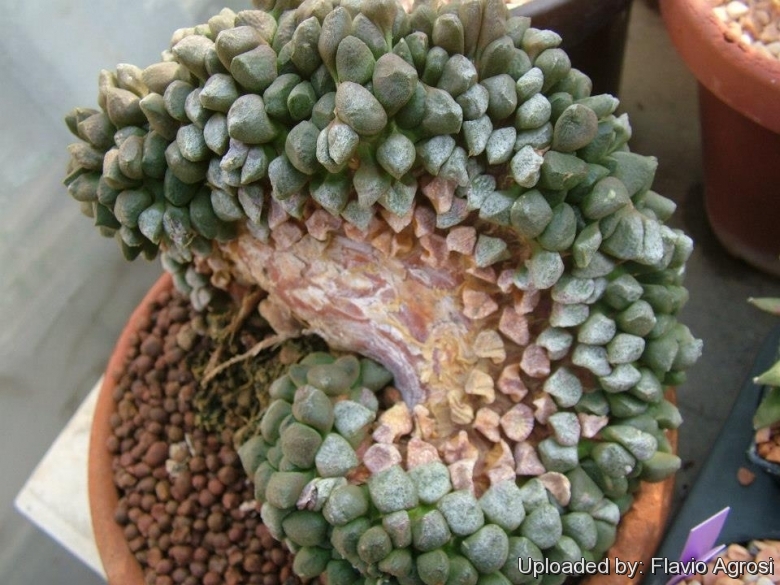= Ariocarpus fissuratus var. lloydii f. cristata hort.
Accepted Scientific Name: Ariocarpus fissuratus K.Schum. in Engl. & Prantl
Nat. Pflanzenfam. Nachtr. [Engler & Prantl] 3, Abt. 6a: 195. 1894

Ariocarpus lloydii f. cristata (Ariocarpus fissuratus var. lloydii f. cristata) Photo by: Flavio Agrosi
Origin and Habitat: Ariocarpus fissuratusSN|2114]]SN|2114]] var. lloydii grows in central Mexico and ranges from southern Coahuila and adjacent Zacatecas to eastern Durango (Nazas, Peñon Blanco).
Synonyms:
See all synonyms of Ariocarpus fissuratus
back
Accepted name in llifle Database:Ariocarpus fissuratus K.Schum. in Engl. & PrantlNat. Pflanzenfam. Nachtr. [Engler & Prantl] 3, Abt. 6a: 195. 1894Synonymy: 22
Cultivars
(8):
back
Common Names include:
ENGLISH: Crested Star Rock, Crested Living Rock
Description: Ariocarpus fissuratusSN|2114]]SN|2114]] var. lloydii is traditionally distinguished from var. fissuratus by its higher, somewhat rounded and more convex stem appearing above the ground.
Crested form: The crested Star Rock (Ariocarpus fissuratusSN|2114]]SN|2114]] var. lloydii f. cristata) is a very rare, slow-growing and highly priced crested cactus forming odd sculptural shapes. Its stems fan out and can get very big making a spectacular specimen. The crested form - despite to its beauty - is still very rare, pricey and sought after by collectors.
Habit: Solitary, slow growing geophyte cactus with tubercles slightly projecting above ground level. The tuberous body is mostly below the soil.
Stem: Grey, or olive-green, fan shaped slowly forming brain-shaped cushion that can reach a considerable size (up to 3-12 cm high and 70 cm in diameter, or more).
Tubercles: The tubercles of var. lloydii are very different from those of the standard Ariocarpus fissuratusSN|2114]]SN|2114]] and easily recognizable. They are imbricated, ovate, broad at base and usually more rounded at the apex, about 2 to 3 cm wide. They lack edges and lateral longitudinal furrow (or are only weakly fissured). They are only finely rugose with quite coarse, often confluent papillae in the whole surface which form transversal ledges and irregularly warty.
Areoles: Filled with a dense mass of hairs, up to 3 mm wide, sometimes confined to middle of tubercle faces instead of extending to tips.
Flowers: These plants have a woolly crown, from which emerge 3 to 4 cm broad, white to purple (usually pink) 2 times wider than long when fully expanded. Inner perianth-segments oblong-oblanceolate; style and stigma-lobes white.
Blooming time: October, November. Flowers last for 3 to 4 days.
Fruit: Ovoidal, pale green.
Seeds: Black, tuberculate-roughened.
Root: Each plant has a large turnip-like taproot, which lies below the soil surface and serves for water storage.
Subspecies, varieties, forms and cultivars of plants belonging to the Ariocarpus fissuratus group
Cultivation and Propagation: It is not too difficult in a greenhouse, although grows quite slowly. It is usually seen as a grafted plant but can grow on its own roots too.
Soil: Use a mineral well permeable soil with little organic matter (peat, humus).
Exposure: They need a good amount of light shade to full sun this help to keep the plants healthy, although slow growth.
Watering: Water sparingly from March till October (weekly during summertime, if the weather is sunny enough), with a little fertilizer added. Less or no water during cold winter months, or when night temperatures remain below 10° to prevent root loss. It is sensitive to overwatering (rot prone).
Fertilization: Feeding may not be necessary at all if the compost is fresh then, feed in summer only if the plant hasn't been repotted recently. Do not feed the plants from September onwards as this can cause lush growth which can be fatal during the darker cold months.
Hardiness: Keep perfectly dry in winter at temperatures from 5 to 15 degrees centigrade. (but it is relatively cold resistant and hardy to -5° C, or possibly colder for short periods) In the rest period no high atmospheric humidity!! (Temperature Zone: USDA 9-11)
Crested growth: Unlike 'monstrose' varieties of plants, where the variation from normal growth is due to genetic mutation, crested growth can occur on normal plants. Sometimes it's due to variances in light intensity, or damage, but generally the causes are unknown. A crested plant may have some areas growing normally, and a cresting plant that looks like a brain, may revert to normal growth for no apparent reason. If you have any of the crested part left you need to remove the normal growth and leave the crested part behind this will need to be done regularly.
Propagation: Grafting or cuttings. Plants are usually grafted onto column-shaped cacti but proved to be able to produce their own roots if degrafted. Cuttings will take root in a minimum temperature of 20° C (but better in hot weather). Cuttings of healthy shoots can be taken in the spring and summer. Cut the stem with a sharp, sterile knife, leave the cutting in a warm, dry place for a week or weeks (depending on how thick the cutting is) until a callus forms over the wound. Once the callus forms, the cutting may be inserted in a container filled with firmed cactus potting mix topped with a surface layer of coarse grit. They should be placed in the coarse grit only; this prevents the cut end from becoming too wet and allows the roots to penetrate the rich compost underneath. The cuttings should root in 2 to 6 weeks. Large crested piece must be placed on the soil surface without burying the plant base down in the soil.











